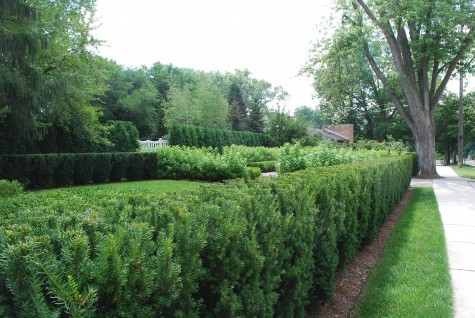I want this post to be about what could of been done to achieve the desired look intended.
I witnessed the installation of this hedge - this past July. Everything in me wanted to go out and speak to the workers and owners of the home, but it wasn't my place and now I feel bad.
Ways this went wrong:
1) Planting time: wrong month and what was the driest summer the GTA has seen in a long time. Hedges like this should be planted in late May and or mid-late September. Spring and early fall planting gives the plants a chance to acclimate to their new situation; when cooler temperatures allow developing roots to grow. Strong root development would give the evergreens more stamina in the heat of the summer.
2) Distance from the sidewalk: this is where most folks go wrong. I get you want to have a perimeter border to your property, but two major factors need to be considered first:
- Municipal sidewalks are not your own: City of Toronto maintains them and provides winter maintenance and the occasional removal and repair of concrete. Since these yews were still young in stature, their mature size would eventually hug the sidewalk edge and you can't prevent outsiders from damaging the evergreens when they perform maintenance. Salt damage, the occasional "whoopsie" - you know, when the slice of a plough blade scrapes into your turf. Not to mention any infrastructure they need to access below can easily cause hedges to be damaged. You need to think long term when designing a hedge location.
- Foot traffic and dog urine. Enough said.
3) Not considering mature sizing when selecting their location. Depending on the evergreens chosen, certain cultivars require more pruning then others. To have nice thick hedges in the GTA, I'd recommend you allow at least 18-20" breadth of growth to help sustain its health. The aim is trimming the hedge nicely into shape as it fills in. These yews, I'm afraid, are too close to the walkway and will require more heavy shearing to maintain shape. You need to keep the foliage and branches away from foot traffic.
4) Position relative to sun/wind exposure. This house faces North, placing the sidewalk on the north/west facing exposure. Sun refracts heat off of the concrete, not to mention the roadway, which has no boulevard grass to buffer the sun's rays or salt spray from salter trucks.
5) Soil prep is key before planting. A trench should be dug twice as wide as the container and the soil should be thoroughly amended with amazing soil, mixed with existing soil prior to installation. A great top dressing of composted mulch would be a total bonus.
Here is an example of how a hedge along a walkway can be done successfully...
Photo courtesy of Dirt Simple:
Great hedging lines are enhanced with a buffer zone of mulched earth and a 2 foot turf boarder in front of the Yews. This will help keep foot traffic and municipal "paws-off", and prevent any possible removal or damage by others.
Well done, Dirt Simple!





Thanks for sharing these tips. In my opinion, Hedge trimming is almost always best done during spring. A well-maintained hedge keeps your garden looking neat and tidy.
ReplyDelete